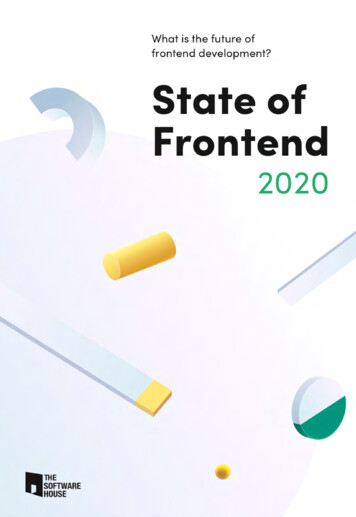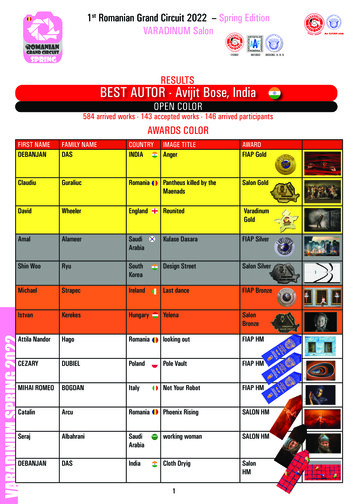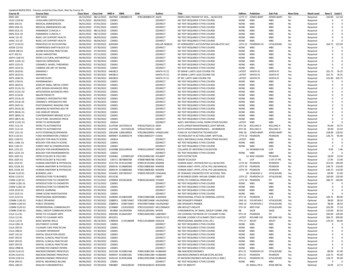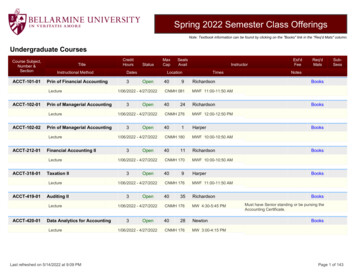
Transcription
State ofFrontend2022
Table of content01Intro0309Developers & work te generators28Hosting12Good practices4713 Future of frontend54BIOs59Meet our expert commentatorsSSG solutions are on the rise0744The frontend may be entering a stability phaseTypescript continues to make web development less frustrating06TestingGood practices are not one size fits all - they depend on your teamRedux & Lodash – widely used, liked, and disliked?05 TypeScript41Positive surprises in the state of testing: frontend developers have never tested more!Developers choose frameworks with good practices in mind04Code managementBrowser editors are on the rise. Is this just an effect of remote work?For software engineering, the biggest change over the past few years has been remote0338What’s up with 42% to WebSockets? I’d expected it to hit less than 5%Is frontend tired of new trends, and looking for stability?02Browser technologies31Deployment. Will mass migration to the cloud mean the end of traditional hosting?08Micro Frontends35Micro Frontends are on their way to maturity02
Chapter 01IntroIs frontend tired of new trends,and looking for stability?Aleksandra Dabrowskareport’s Editor-in-Chief
Chapter 01 IntroThe last two years haven’t been the easiest and prompted a lot of changes globally. The IT industry was directly engaged in digital transformation since life as weknew it basically moved online. Frontend developmentwas also subject to change – from technologies to goodpractices and working conditions.It seems that the most famous frontend developmentjoke “new day, new framework” has aged poorly. Sure,new frameworks and libraries do emerge but the racetowards trendy innovations slowly gives way to maturity and stability in certain areas.The goal for the State of Frontend is still the same –we want to see the real day-to-day perspective fromfrontend professionals of all levels and backgrounds.Inside you’ll find answers to which technologies we loveto hate but still use, which practices are sacred andwhich are neglected, and what future people see forthemselves and the frontend landscape.We’re excited to see a varied representation of frontend specialists, as our respondents come from 125 different countries! We hope that in the future we’ll manage to expand our reach even further.State of Frontend 2022Report in numbers3703survey filled in125countries represented19frontend experts comments04
Chapter 01 IntroOn top of that, we’ve invited 18 contemporary frontendexperts to share their thoughts and comment on surveyresults. Their insights are not only a fact-of-the-mattersource of knowledge but will also provide you with foodfor thought on different frontend development topics.Shout out to each and every one of our commentators the report wouldn’t be so awesome without your knowledge and experience. Show them some appreciation,and meet them in the bio section below.We encourage you to actively participate in the resultanalysis too! If we know anything about frontend folksit’s that everybody has their opinions and rarely keepsthem to themselves – which is great because it pushesthe entire industry forward. Every diagram and tablehas a “share” button, in case you want to start a discussion with your friends or share only one specific datapoint of the report.Finally, a big “thank you” to all 3703 frontend peoplewho filled the survey – without you, there would be noreport!State of Frontend 202205
Chapter 02Developers & work conditionsFor software engineering, thebiggest change over the pastfew years has been remote workGergely OroszThe Pragmatic Engineer, author
Chapter 02 Developers & work conditionsA whopping 56% of respondents reported working remotely, and only 5% of themwork in the office. The concept of mass remote work is so new that the survey in2020 did not even measure this data point.How does your work look like now?The big question for the year is whether full-remote work will be here to stay, orwe’ll see hybrid work gain more popularity. Most engineers clearly prefer working remotely – there’s no commute involved, there are fewer distracting taps onthe shoulder. However, it remains a challenge to share information and replicatespontaneous discussions that have existed in the office35.3%It’s not just frontend engineers who dofrontend development5%This year, some of the job titles people doing frontend development shared inthe “other” option included:A bootcamp student just starting out learning frontend,59.7%A self-taught developer studying at a non-technical university who fell inlove with frontend,A product manager who sometimes pushes code to production,Remote onlyHybridOfficeDeveloper advocate who helps out the frontend team every now and then,State of Frontend 202207
Chapter 02 Developers & work conditionsFrontend development architect,Design system director,A designer who also codes,How long have you been in the frontend development game?Graphic designer & developer,More than 5 years28.4%More than 10 years24.1%More than 3 years22.8%Head of Everything: a one-person developer shop doing everything, includingfrontend development.This should be of no surprise: but it’s always a nice reminder of how frontend is anaccessible area and one where it’s still common enough to get involved withoutmuch frontend background.Working within larger frontend teams isbecoming more common27% of respondents reported working at a company with more than 50 front-endengineers. At the same time, 30% of developers shared how 5 or fewer frontenddevelopers work at their company. 50% of respondents work at companies with 10or more frontend engineers.More than 1 yearA few months18.9%5.7%This statistic shows an interesting duality. There are almost as many frontend engineers who work at companies with massive frontend teams as there are onesworking on few-person teams or alone.State of Frontend 202208
Chapter 02 Developers & work conditionsThe developer experience and the expectations at these companies are vastlydifferent. Large companies will have developer experience and frontend platformteams more often. Mentorship is more common. In smaller places, a lot more isdown to each developer, and there are fewer options to get feedback. As a frontend engineer, I’d recommend, over time, working in both environments to maximize learning.How would you describe your current status?100%90%The statistic of 50% of frontend engineers working at companies with 10 or morefrontend developers, and 27% of them at places with 50 or more, could also be aninteresting prompt for teams building tools for larger frontend teams. There seemto be a growing number of these places.80%70%60%50%Few engineers filling out the surveywork at non-tech companiesOnly 18% of people filling out the survey said they work at non-tech-first companies. 82% identified as working at a software development company, developeragency, or tech-first or digital-first companies. It’s hard to tell if the survey didn’treach people who work at more traditional companies, or there really are moreengineers working at places where software is core to the business.40%30%20%10%Mid-levelSenior developerChief technology officerLead developerJunior developerHead of technologyOtherEither way, it’s worth keeping in mind that the survey results come overwhelmingly from places where tech and software are more of a profit than a cost center.State of Frontend 202209
Chapter 02 Developers & work conditionsWhat’s the size of the company you work in?How many frontend developers are there at your company?100%90%Less than 529.2%10-5023.8%80%70%60%50%5-1019.9%More than 10018.2%40%30%20%10%50-100501 employees51-200 employees11-50 employees2-10 employees9%201-500 employeesI’m a one-person company/freelancerState of Frontend 202210
Chapter 02 Developers & work conditionsWhich one of the following best describes your company?Software development company / developer agency41.6%Tech-first / digital-first company41.2%Non-tech-first company12.3%Government organizationOtherState of Frontend 20221.9%2.9%11
Chapter 03 FrameworksDevelopers choose frameworkswith good practices in mindSébastien ChopinCEO at NuxtLabs & author of Nuxt
Chapter 03 FrameworksFor me, the story of 2022 results is the rise of frameworks. It seems that developers are increasingly looking to meta frameworks to help them work faster andwith greater confidence. The survey reveals that respondents are increasinglylikely to be concerned with following best practices (e.g. performance and end-user experience) which completely explains this rising move toward meta frameworks.Accessibility is a major focus for respondents this year, with 63% predicting it willgain in popularity over the coming years. Frameworks tend to provide differentways to solve this, with some notable examples including Next/Nuxt Image, HTML-validator, and WebHint. The Chrome Aurora team is working with meta frameworks such as Angular, Next, and Nuxt to make sure they implement these bestpractices. I predict we will likely see continued improvement from all these majorframeworks in the upcoming years.Over the past year, which of the following frameworks have youused and liked?100%90%80%70%60%50%40%30%20%Component-driven development is also embraced by most developers, whichmakes sense given the popularity of React, Vue, and Svelte, and even web components (as in this year’s indie success story - Wordle).State of Frontend larSvelteGatsbyNuxt.jsRemix13
Chapter 03 FrameworksProgressive web applications are gaining popularity as well, with developers keento make the most of cross-platform development using the same core codebase.We are also seeing groups like Open Web Advocacy push Apple to embrace theopen web. This is definitely a space to follow.Over the past year, which of the following frameworks have youused and disliked?100%90%Headless CMS is also advancing, with greater adoption and more integration intoframeworks. Close to home for me, new Prismic, Strapi, Sanity, Storyblok, andDirectus modules have already been released for Nuxt 3, working with zero configuration.80%70%60%I also noticed another trend that is not mentioned explicitly in this survey. Edgerendering was initially driven by CloudFlare and its worker platform. It’s no accident that most of the deployment targets on the survey have released or implemented their own serverless or edge functions, and this is being quickly adopted by users. Frameworks such as Nuxt 3, Remix, or Sveltekit are moving inthis direction, enabling on-demand rendering directly at the CDN level. With thecorresponding gains in decreased latency and lower cost for server-renderedapplications, it’s my prediction that this will be a big focus for 2023.State of Frontend emixVue.jsBackbone.jsEmber.jsNext.jsSvelte14
Chapter 03 FrameworksWhich of the following frameworks would you like to learn in ixNext.jsEmber.jsOtherBackboneState of Frontend 2022Vue.jsReactNuxt.jsGatsbyAngular15
Chapter 04LibrariesRedux & Lodash – widely used,liked, and disliked?Andrzej WysoczanskiHead of Frontend at The Sofware House
Chapter 04 LibrariesWhatever you think about Redux and Lodash, they are definitely used by frontend developers (willingly or unwillingly). Both landed at the TOP3 of liked anddisliked solutions which makes me wonder, why would people use solutions theydon’t like. I have a couple of theories.Over the past year, which of the following libraries have you usedand liked?From my experience, Redux is widely used by software companies and their customers because it’s great for large projects requiring complex state management.However, Redux has quite a difficult entry threshold. If a developer learns Reduxfrom scratch, and it’s something brand new to them, they may not initially like it.But, learn they must and learn they want, as almost 20% of respondents want tomaster Redux in the future, even though it’s so difficult. Or maybe people realizethat in order to score a nice job in frontend development, having Redux experience is good for their resumes.100%As far as Lodash is concerned, the only logical explanation I have is that our respondents must have entered projects with these solutions in place, and they usethem out of necessity, not fun.40%90%80%70%60%50%30%20%It seems that frontend people move from Moment towards Date-FNS, and that’sa good sign. I was shocked that over 40% still use Moment in their project, no matter what the sentiment. This library has already lost support, and even its official website has a note from creators stating that if you’re considering using Moment, you should probably look for alternatives. Luckily, only 5% of respondentsare eager to learn Moment in the future, so it’s probable that this library lost itsmoment and is heading towards a decline.State of Frontend lloRxJSOther17
Chapter 04 LibrariesAxios, our “congeniality” prize winner with over 60% votes definitely entered thestability phase. It’s been on the frontend market for a good while, people knowit well, and it’s more of a “standard” than a “trend”. No wonder, it offers decentdata download, communication, and general cooperation with the backend. Thequestion remains, the Axios naysayers would rather use GraphQL or they just honestly don’t like working with it?Over the past year, which of the following libraries have you usedand disliked?100%90%Having mentioned GraphQL, I need to comment on two more solutions here. Since Apollo is used for seamless connection to GraphQL, I thought it will be muchhigher on the “used & liked” category. My hope was revived when I noticed that40% of devs want to learn Apollo in the future (which saved it the first spot). Thatmeans Apollo’s community is steadily growing, and I expect more users of this library in the next report.80%70%60%50%40%Apollo, with its easy-peasy configuration is the most famous one here, but maybeRelay can be its biggest competition soon. Relay is more complex and works onlywith React and React Native apps but 26% of frontend devs want to learn thislibrary. If more people use Relay, the more projects implement it, and that canresult in bigger engagement. I’ll keep my eye on GraphQL clients because I havea feeling that it will be the place where the frontend world can be surprised in thefuture.State of Frontend polloRamdaDate-FNS18
Chapter 04 LibrariesWhich the following libraries would you like to learn in the mentOtherState of Frontend 2022RelayReduxRamdaDate-FNSLodashAxios19
Chapter 04 LibrariesDesign systems with no clear winnerOlivier TassinariCEO at MUI and co-creator of Material-UIOver the past year, which of the following design systems wasyour favorite go-to solution?100%The design system space is very fragmented. There is no single design system thatgoes beyond 24% of the market. This is a spark difference with React which has thelarge majority of the frontend market. I think that this can simply be explainedbecause the choice of the design system for a company is mostly an “artistic”one, and no two people have the exact same design tastes.As a side observation, there might be a possible bias in the results. The surveyproposes “Material UI / MUI” as a predefined answer, I’m glad to see we are theleading option, however, for most people Material UI is synonymous with MaterialDesign. So it’s not clear if the respondents chose this answer from a design (designsystem) or code perspective (Material Design React UI library/framework).90%80%70%60%50%40%30%20%10%My own custom solutionsMaterial UI / MUITailwind UIBootstrapOtherAntDesignVuetifyState of Frontend 202220
Chapter 04 LibrariesStyling tools. SCSS eats half of the chartpieChris CoyierFounder of CSS-Tricks and CodePenOver the past year, which of the following styling tools was yourfavorite go-to solution?100%90%Wow, look at SCSS go! If a kid was born the day SASS was released, they’d be learning to drive today. That’s incredible longevity for any software tool, especiallyin the fast-moving world of front-end development tools. Having nearly half ofrespondents say they don’t only use SASS but it’s the favorite is incredible tome, and I happen to agree since it’s a favorite of mine as well. I think the syntaxof it is quite nice, even though I tend to only use a handful of features like nestingand light mixin usage. Sass is, in a sense, up against CSS itself these days. I wouldguess variables are one of the top reasons developers reach for Sass, but CustomProperties have arrived in CSS and their support is ubiquitous, all but eliminatingthe need for Sass variables. Even nesting has momentum in CSS standards bodies,so we’ll see if that one makes a dent in Sass usage as the years tick by.80%70%60%50%40%30%20%10%Sass is a tricky one though, it doesn’t mean that’s all you’re using. For example, PostCSS (only represented in the „Other” section here) is somewhat designed to beused in conjunction with Sass, at least optionally. Similarly with CSS Modules. Whileyou can use CSS Modules alone, you can almost just as easily use it with Sass. Thathappens to be a favorite combination of mine, and it’s not particularly esoteric asthe wildly popular Next.js ships out of the box supporting this combo.State of Frontend 2022SCSSTailwindOtherVanilla ExtractStyled ComponentsCSS ModulesEmotionChakra21
Chapter 04 LibrariesA monster showing for Styled Components as well! What strikes me about thisis that the question is just about the usage of styling tools, but Styled Componentsall but implies the usage of React as well. So to see this big of a slice of the pie,especially combined with Emotion, Chakra, and Vanilla Extract, all of which I would guess primarily see usage in a React environment, shows off just how wildlydominant React was for participants of this survey. It makes me think of the otherbig JavaScript frameworks a bit. Where are the Vue people at? I don’t see anything specifically called out in Other. They might just not think about it? Styling isa built-in thing in Vue Single File Components land. You don’t make a ton of stylingtool decisions in Vue, as it’s just there for you. And this brings me back to Sass a bit.Just as it’s trivial to use Sass in Next.js, so too can you use easily use Sass in Vue,Svelte, or newer meta frameworks like Astro.It’s not terribly surprising to see that regular ol’ CSS is barely a blip, knowing howheavily JavaScript framework usage is represented here. Once you’re in a component-driven architecture, having CSS that is scoped to those components andoffers additional utility through the availability of JavaScript, it makes sense thatpeople take advantage of that, despite the thickening of the stack, as it were.Tailwind’s popularity also comes as no surprise here. If you asked me five yearsago if I thought something like Tailwind would become popular, I would havesaid “no”, but I would have been wrong. I’ve heard from countless developersthat the idea of using HTML classes to style things just clicks for them. I have myown suspicions. If done well, the CSS produced by Tailwind is highly likely to besmaller (extra important for a blocking resource like CSS) which is a nice performance benefit from a tooling choice people seem to like anyway.State of Frontend 2022It’s nice to see tools like Vanilla Extract trying to offer a modern variety of developer ergonomics in styling, and also be very focused on ensuring that good performance is the default behavior. Which generally means „extracting” „vanilla” CSS,if you follow their naming pun.All this makes me think what the results would be if we could see data on, say,the styling choices of the top 5000 websites by traffic. Or the choices made onthe last 5000 websites published on the internet. Or the top 5000 most activelydeveloped websites on GitHub. Would it be similar? It’s hard to say whether theywould be completely different. But I think of that staggering statistic followingWordPress around: 43% of the internet. It’s not that you can’t build a JavaScriptframework-powered WordPress site, some people do, but I’m sure a tiny slice of allthose WordPress websites. So what are they doing? Are they the big Sass users?Wouldn’t you think a decent amount of them are vanilla CSS just because WordPress itself doesn’t offer any built-in styling tools? Or maybe most of those sitesaren’t really built by developers, but just self-serve deployments?It’s certainly fascinating to watch styling tool choices change over the years. Theonly thing I’m quite certain of is that a few years from now, there will be surpriseson this survey that would be impossible to guess today.22
Chapter 04 LibrariesDevelopment tools influenced by cloudIves van HoorneCo-Founder of CodeSandboxOver the past year, which of the following development toolshave you used?100%It’s great to see this topic being covered in the State of Frontend survey. You cansee that more people are getting interested in using online code editors for some oftheir work, which is super exciting. Cloud development will only continue to grow,and I expect to see even more programmers and companies moving their development environment from the local to the cloud.90%80%70%60%The survey confirms what we’ve already noticed at CodeSandbox. We’ve seenmore and more people moving their development online, which also suggests improved general interest in cloud development. Over the past year alone, peoplehave created over 12 million sandboxes, which makes for half of our total sandboxes ever created!50%40%30%20%I’m very excited about the future because I believe that the cloud will make software development more accessible and collaborative. And I’m very happy to seethat interest reflected in frontend developers’ answers. As for my expectations forthe future here, moving to cloud development may happen much sooner than weall think State of Frontend 202210%EslintPrettierWebpackParcelMy own custom solutionsTSLintOtherViteEsbuildRollupBun23
Chapter 05TypescriptTypescript continues to makeweb development lessfrustratingMarcin GajdaFrontend Team Manager at The Software House
Chapter 05 TypescriptTypeScript doesn’t intend to stop gaining more and more publicity with each passing year. You can especially see it, if you compare 2022 answers with those fromtwo years ago. The number of people using TypeScript raised over 7 percentagepoints, already being at 84%!Over last year, have you used Typescript?We all can probably agree that TypeScript is universally embraced by developers,and the industry won’t let go of this technology in the upcoming years. How did ithappen though? In online discussions, people often praise TypeScript for how itprevents a whole class of bugs before they even happen. That in turn, makes development faster and apps more reliable.I don’t intend to argue here but since you asked me what really makes so manydevelopers love TypeScript, I’m going to say that TS made web development wayless frustrating than it was before. After far too many years of web development feeling laborious and painful, frontend developers don’t want to re-live theexperience of switching between the code editor and the browser back and forthmultiple times to guess why “undefined is not a function”. These “snow is white”kinds of errors were mostly caused by misspelled variables or misplaced parameters.15.9%84.1%YesState of Frontend 2022No25
Chapter 05 TypescriptThen TypeScript came to our rescue, being baked by Microsoft and armed withthe support in all major IDE. Writing code on frontend feels way more controlledand straightforward now. Personally, I also enjoy the extra layer of fun added tothe whole development process by the possibility to design data structure shapebefore writing the code that utilizes it.TypeScript not only attempted to win over developers’ hearts but also fought itsway to become the frontend industry standard, not only for Angular projects. It’ssafe to say that new commercial projects NOT using TypeScript at all have already been scarce, and it will only be harder to find them in upcoming years.State of Frontend 2022If you compare the questions about using TypeScript with company type, it’s clear that the tech industry confidently moves towards Typescript in their softwareprojects.To support my claim further, people who didn’t touch TypeScript over the pastyear work more often in non-tech companies or government organizations.Nothing surprising, because these organization types are infamous for being setin their ways and sticking to older solutions. This in turn often infuriates frontenddevelopers, who don’t enjoy working with obsolete technologies. The results: 13%vs 20% for the more tech-related and dynamic competition26
Chapter 05 TypescriptFuture of TypescriptAs far as the future of TypeScript is concerned, predictions changed quite a bit. In2020 it was a close call between the top three options. The respondents didn’t givea definitive answer about what will happen between TypeScript and JavaScript.My bet is that two years ago we still weren’t exactly sure if TypeScript is just atemporary fad or something that will stay with us for longer. Considering howmuch constantly happens in the world of frontend, and how often new solutionsemerge, a bit of caution is perfectly understandable.The State of Frontend 2022, brought a clearer answer. People who think thatTypeScript will become the primary solution for web development are in thegreat majority with 43%. I know, the result is still not over 50% yet, but if you wereplaying „Who Wants to Be a Millionaire?” and that was your result in the “Ask theaudience” question, wouldn’t you bet on it? I think the main reason behind the shift becomes clear when we look at new, emerging solutions. There’s a noticeableincrease of libraries written in TypeScript natively, and most of the new development tools come with out-of-the-box TypeScript support.Last but not least, we could observe in real-time how the “JavaScript will turn intosomething like TypeScript” question slowly comes to life. In March 2022 it becamesurprisingly more realistic than ever when Microsoft announced their proposal tointroduce the type syntax from TypeScript in JavaScript.In your opinion, which of the following future of Typescriptscenarios seems most likely to happen?TypeScript will overtake Javascript and become a newfrontend standard43%JavaScript and TypeScript will be equally popular27.6%JavaScript will turn into something like Typescript16.6%JavaScript will remain the frontend standardEveryone will forget about TypeScript11.8%1%It means the browsers will understand TS but won’t support type checking. Fornow, the frontend community gave the proposal a cold reception and I don’t thinkit has a chance to be accepted into the ECMA standard in the current form. It alsodoesn’t mean that JS will morph into a TS clone, but definitely, something is in theair.State of Frontend 202227
Chapter 06Static-Site generatorsSSG solutions are on the riseSamuel SnopkoHead of DevRel at Storyblok
Chapter 06 Static-Site generatorsIncreasingly, huge companies are not afraid to switch to headless CMSs with SSG- Jamstack solutions are no longer a new cutting-edge technology, and they don’tseem experimental to them anymore.This change is leading to a rise of SSGs with unbeatable performance and caching,and we can already see many new frameworks like Remix, SvelteKit, and Astro,who want to grab their piece of the market cake. I think this new competition willlead to some exciting surprises in the following months, and the leading trinityof Next, Gatsby, and Nuxt will need to evolve even faster!Over the past year, which of the following static-site generatorshave you used?100%90%80%The most important feature will be the incremental generation, which will soonbecome a must for every framework. This makes faster and easier - without theneed to regenerate the whole website, but only the portion that needs to be updated. Additionally, I expect a massive jump in localization and personalizationstrategies, which will become internal parts of the frameworks.70%60%50%40%30%20%10%Next.jsState of Frontend 2022NoneGatsbyNuxt.jsOtherHugoVuepress29
Chapter 06 Static-Site generatorsWhich of the following static-site generators is your favorite towork .4%VuepressOtherState of Frontend 20221.2%6%30
Chapter 07HostingDeployment. Will mass migration to the cloud mean the endof traditional hosting?Gift EgwuenuDeveloper Advocate at Cloudflare
Chapter 07 HostingThe first thing that I’ve noticed is that more folks are moving away from the traditional hosting on their own servers, as the result dropped by 8% points compared to 2020 answers.Personally, I think this was always bound to happen and I don’t think it’s a badthing that we are moving away from traditional hosting. Developers are lookingto optimize their time and productivity and if they can find a way to take out mostof the work required for initial setup, they will adopt those services. And that’swhat I see happening here, I think in a long run more people will move away fromit but will it ever stop existing? No, I don’t think so, some systems still require verycustom hosting that they may not get from a provider so they choose to maketheir own. The migration is something that will continue to happen though as cloud hosting evolves.The alternative, moving frontend hosting towards cloud providers, received acombined result of 64%! Amazon Web Services still remain top of the list with 45%responses, which is unsurprising considering AWS i
meworks such as Angular, Next, and Nuxt to make sure they implement these best practices. I predict we will likely see continued improvement from all these major frameworks in the upcoming years. Component-driven development is also embraced by most developers, which makes sense given the popularity of React, Vue, and Svelte, and even web com-










